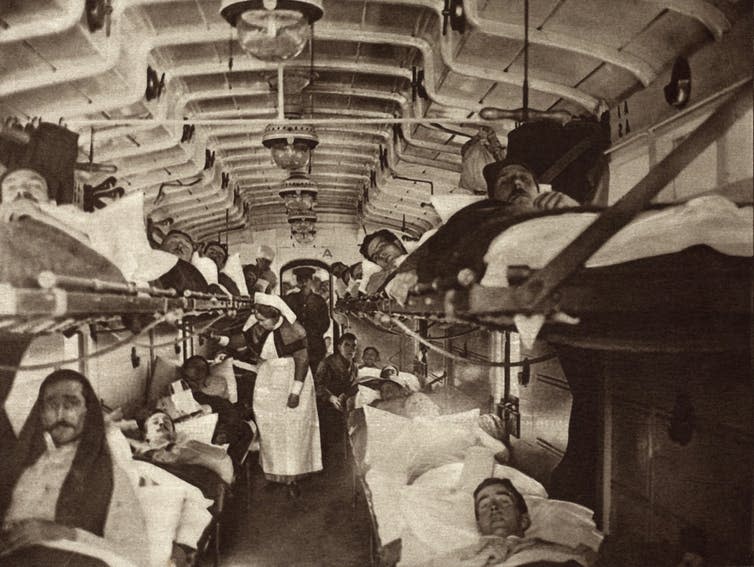The forgotten story of how horrors of the Great War haunted Britain's home front

World War I – or the “Great War” as it was known at the time – is at the forefront of many people’s minds as we inch closer to the centenary of the 1918 Armistice. The images that have filtered down through the generations are largely those of the frontline trenches: blood, mud, smoke, rats, lice, death. The carnage of the Somme and the butchery on the Gallipoli beaches. Ironclad beasts traversing the wastes of No-Man’s-Land. Giant steel ships blowing each other out of the water at Jutland. Occasionally, zeppelins hanging over an anaemic London skyline. What is discussed far less is the story of how Britain managed to carry on at home.
Television dramas and radio plays offer little more than entertaining soap operas. The truth of the home front was far less melodramatic, though nonetheless fascinating. People in the UK were having to carry on as they did before. They still had jobs to go to, families to care for, and homes to keep. But now they had to deal with it all in the absence of their serving men and women, as well as the threat of conquest from over the seas.
The nation’s civilian hospitals were not spared the restrictions and requirements of this total war. Demands were made by the War Office from the very beginning, even before the full extent of the carnage was realised. Having learned lessons from the Boer Wars in South Africa and the Russo-Japanese War, the Royal Army Medical Corps and the Army Medical Service developed a system that would transport wounded soldiers from the battlefield all the way back home to “Blighty”.
Waves of wounded
My research focuses on the impact of this in the English counties of Derbyshire and Nottinghamshire, using original printed documents stored in county and national archives, private collections and libraries.
Major-General William MacPherson’s documentation of the war, for example, details how many different types of hospitals were cleared at the outbreak of war, including mental hospitals and sanatoria, to accommodate the treatment and convalescence of wounded soldiers. Furthermore, civilian general hospitals were requested to make efforts to clear beds and even entire wards to allow for the treatment of wounded soldiers. This clearly was going to have a major impact on Britain’s civilians.

In the annual reports of Chesterfield Hospital, Derbyshire Infirmary, and Nottingham General in 1914, the hospitals enthusiastically offered their services free of charge to the war effort, declining any grants by the War Office. Indeed, on August 22 of that year, the Nottingham Evening Post published a letter from the War Office stating that further offers of “houses, &c., for the use of sick and wounded … for the present no more are required”.
But by the end of 1914, after facing the devastating consequences of the Mons Offensive and the mass exodus of soldiers and civilians from Belgium, the reality began to sink in.
Whatever early illusions the hospitals had about their potentially minor role in the war effort were smashed. This was partly due to the fact that nursing, medical and domestic staff had been lost from the labour market. Either by volunteering or eventually being called up for military service, hospital medical staff had dwindled to very dangerous levels by 1915. And meanwhile, the injured flooded in.
By 1916, Nottingham Children’s Hospital nearly had to close its doors because it had so few doctors. Derbyshire Infirmary had to call on local GPs to staff its wards, and the Nottingham General even had to call doctors out of retirement. Even plumbers had to be fought over, with appeals made directly to the War Office by Nottingham General so that they could keep their boiler going.

As the number of medical and nursing staff grew smaller and smaller, civilian waiting lists grew longer and longer. In early 1915, Chesterfield made the difficult decision of refusing further wounded soldiers until they could diminish the backlog of civilian patients. Eventually, they managed to open up new beds to accommodate more patients.
On top of all other considerations, the economic situation of the war meant costs were rising for the hospitals, too – Nottingham General saw a 73% increase in total expenditure between 1913 and 1916. The grants from the War Office were proving to be inadequate for the treatment of the wounded soldiers, and hospitals across the country were being pushed into deficits.
War at home
While many think of the Great War as being relatively removed from the British people, and without the mass bombing raids and threat of invasion that coloured World War II, British citizens did, in fact, witness the terrible fallout of the conflict on their very doorsteps.
Upon the arrival of the first hospital train in Nottingham on October 6, 1914, newspapers turned out to photograph the scene. That first train contained only a few soldiers, but soon more and more wounded troops were received into the towns and cities of the UK.
The majority of these soldiers were returning as “accident and emergency” cases, requiring urgent, expensive and skilled attention as soon as they arrived. By October 22, 1914, 55 wounded soldiers had already been treated in Nottingham alone, and were starting to be sent back to the front. It was just the tip of the iceberg and things would get much, much worse.
The realities of war were literally brought home to the British people in the form of crippled and maimed soldiers – and not just Tommies, but troops from all over the empire. As they filled up the country’s overcrowded hospitals, the truly global scale of the Great War became all too apparent.
This article was originally published on The Conversation. Read the original article.

Edward Cheetham received funding from the Midlands Three Cities Consortium (AHRC). Edward Cheetham is also a member of the Labour Party

 Yahoo News
Yahoo News 
